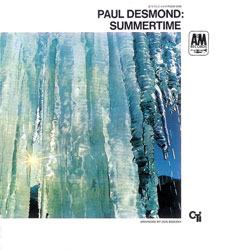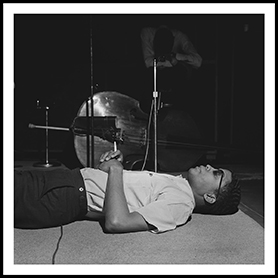

|
Soundclip:
|
| See Steve's Hand-Written Solo Ac. Piano Intro
Transcription |
Herbie
Hancock's Solo Acoustic Piano Introduction & Tag Comping on: "Someday My Prince Will Come"(Frank Churchill-Larry Morey) Several years ago, when I had transcribed and presented Clare Fischer's gorgeous solo Fender Rhodes Intro on "Where Is Love?" as heard on Cal Tjader's 1977 "HERE AND THERE"(Fantasy) album, I wanted to make certain that I had done a reasonably good job writing it out, so I sought out the wisdom and expertise of Rob Mounsey, who is one of the greatest musicians that I know, and obviously, a superb keyboard player. When Rob saw the transcription, and perhaps played through it, we spoke via phone and he simply said something like this:  "Why didn't you write it all out in 4/4 and then just say Rubato?" Indicating that that would have taken care of it. I had tried to indicate the all-important sense of space by using commas and squiggles between the phrases. I wanted it to look like and what it sounded like to me. So, fast-forward to the year 2024, when I wanted to try to write out Herbie Hancock's magnificent solo acoustic piano intro to "Someday My Prince Will Come" from Paul Desmond's 1968 recording, "SUMMERTIME"(A&M), I thought that, heeding Rob's sage advice, I would just try to write it all out in 3/4 and see what it looked like with only the Rubato indication. And so, this is what you now see. No doubt, Herbie knew the piano at Rudy Van Gelder's studio intimately after so many of his own Blue Note recordings as a leader, and countless others as a sideman, but his touch on the instrument is unmistakable. Making this brief introduction a masterpiece on so many levels. "Why didn't you write it all out in 4/4 and then just say Rubato?" Indicating that that would have taken care of it. I had tried to indicate the all-important sense of space by using commas and squiggles between the phrases. I wanted it to look like and what it sounded like to me. So, fast-forward to the year 2024, when I wanted to try to write out Herbie Hancock's magnificent solo acoustic piano intro to "Someday My Prince Will Come" from Paul Desmond's 1968 recording, "SUMMERTIME"(A&M), I thought that, heeding Rob's sage advice, I would just try to write it all out in 3/4 and see what it looked like with only the Rubato indication. And so, this is what you now see. No doubt, Herbie knew the piano at Rudy Van Gelder's studio intimately after so many of his own Blue Note recordings as a leader, and countless others as a sideman, but his touch on the instrument is unmistakable. Making this brief introduction a masterpiece on so many levels.As the body of "Someday My Prince Will Come" is played by Paul Desmond in the key of F major, it becomes interesting that Herbie Hancock plays the Intro, which is, in essence [A2] of the song, in the key of D major. It makes for a nice transition to tempo when Herbie sets it by arriving at a C7(9sus) sonority and into the song they go with the core rhythm section being Ron Carter (acoustic bass) and Leo Morris (drums). Of course, Leo Morris later became known to most music fans as Idris Muhammad. However, as I have loved this album since the moment that it was released, I wondered to myself if arranger Don Sebesky had thought out all of these harmonic details beforehand, and had just sketched out the chord changes for Herbie in D major. As I was privileged enough to have worked with and for Don Sebesky on countless occasions during the '70s and '80s, I regret never having asked him about this specific album and this tune and chart. Sadly, Don passed away not too long ago or I would have phoned him to see if he could possibly recall that moment during these sessions or in preparing for them. I knew Don to be a meticulous and very caring arranger, where details were concerned, and would at least have given Herbie a guide to where the arrangement might eventually be headed. This, no doubt, after having had a meeting or two with Paul Desmond to confer on in what key Paul felt most comfortable playing this song. I contacted Don's son, Ken Sebesky, to see if there was the slightest chance that Ken might have remembered something about this - or, better yet, if the charts were still stored in some long-forgotten box in a garage somewhere? But, no such luck there. It is highly possible that producer Creed Taylor took all the charts and stored them somewhere. It is a detail that I remain curious about. Herbie's Intro begins with a descending arpeggiated cluster from the A-natural melody note on top. From there, in bar 2, he vaults upwards from the low F# bass note through the full chord of F#7(#9#5) with the beautiful touch of the chromatic inner voice movement from A-natural-Ab-G-G# and up to C# in bar 3 which outlines a Bm9 chord. Though there is no real bass note present, there are those who would label this chord as Gmaj7(#11) - that can be up to you. In bar 4, I love how he uses the delicate nature of the Fmaj7#4 harmony, again with the inner voice of B-natural(#4) moving down to A-natural(3rd). The dynamic of that A-natural is very soft and subtle and all about touch. In bar 5, Hancock adds in yet another beautiful harmonic touch of the cluster that forms the Em9(maj7) chord. Then, in bar 6, while maintaining a sense of an E-pedal, he colors over it with the expected use of a relative V7(alt.) chord, B7(#9#5). Pay attention to the moving voice in the left-hand from E-natural to Eb and eventually landing on D-natural for the chord in bar 7, which I chose to label as Em7(9)/D. In bar 8, Herbie gives us a beautiful pianistic flourish of a briskly articulated arpeggio that outlines C7(9/13), which sustains through bar 9. Bar 10 brings us to the F#m7(sus) played with great sensitivity as Herbie works his way to the very romantic feeling E-natural on top of the C7(9) chord in bar 11. This again features wonderful inner-voice contrapuntal motion - all with terrific usage of the sustain pedal that allows the notes to run together. In bar 12, we really have Gmaj7 with the 6th (E-natural) appearing as a passing tone.  Then, in bar 13, he adds in one last pianistic flourish with another expansive arpeggio of G7(#9#5), but landing on the natural 13th, E-natural, the actual melody note. This then takes us to Herbie Hancock setting the tempo in 3/4. First, at the double-bar, with the pedal of the V7 chord in D major, A9(13sus) for 2 bars with a simple single-note arpeggiated phrase leading to 2 bars of C9(sus), which is the eventual V7 chord of our harmonic target key area of F major. Harmonically speaking, these 4 bars are repeated with the same accentuated rhythmic emphasis on the and-of-1 and 3. It's just beautiful, and seems to glide into the entrance of Paul Desmond's alto sax, Ron Carter's acoustic bass and the drums of Leo Morris. Notice Leo's foot-closed hi-hat is using those same rhythmic accents of the and-of-1 and 3 - a wonderful touch. Then, in bar 13, he adds in one last pianistic flourish with another expansive arpeggio of G7(#9#5), but landing on the natural 13th, E-natural, the actual melody note. This then takes us to Herbie Hancock setting the tempo in 3/4. First, at the double-bar, with the pedal of the V7 chord in D major, A9(13sus) for 2 bars with a simple single-note arpeggiated phrase leading to 2 bars of C9(sus), which is the eventual V7 chord of our harmonic target key area of F major. Harmonically speaking, these 4 bars are repeated with the same accentuated rhythmic emphasis on the and-of-1 and 3. It's just beautiful, and seems to glide into the entrance of Paul Desmond's alto sax, Ron Carter's acoustic bass and the drums of Leo Morris. Notice Leo's foot-closed hi-hat is using those same rhythmic accents of the and-of-1 and 3 - a wonderful touch.Though initially, I wasn't going to transcribe what Herbie plays during the 13-bar [Tag], but I just could not resist giving it a try. Of course, I am not a pianist, nor even a keyboard player by trade, that alone makes it more difficult for me to hear through what Herbie actually plays for all of these voicings which, no doubt, were an integral part of Don Sebesky's chordal arrangement, which he orchestrated later with brassy touches. As this particular type of piano harmony is something that I have always been drawn to, one with wide-open voicings, my desire to try to get it right was on high alert, and I can only reassure you that I did my best. I sent the finished transcription to a couple of keyboard players and they said that it was correct to their ears. So, I will let it rest with that. On the final fermata chord of Emaj6/9, Herbie's voicing is a rich one in the middle of the piano with a sustained brass chord, no doubt derived from Hancock's voicing, and with Paul Desmond choosing typically beautiful notes going down from a high G# to D# and answering that phrase with B-natural descending to F# - a wonderful usage of the color tones: maj7th and the 9th. For those who might be interested, I have already presented Herbie Hancock's acoustic piano solo on "Someday My Prince Will Come" and Paul Desmond's alto sax Solo as well here at KHAN'S KORNER 1. Now you can access everything. A small reminder that this beloved song comes from the Disney animated classic, "SNOW WHITE AND THE SEVEN DWARFS." Just sayin'! As this presentation comes to you in January of 2025, and, knock on wood, we will have experienced a relatively mild winter here in the northeast of the USA, Spring will be coming soon, and like everyone here in New York, I can't wait for that! So, here's wishing everyone a wonderful Spring and a most creative and productive year ahead!!! In closing, here's hoping that everyone had a wonderful Holiday Season 2024, and that we are wishing you all a very, very HAPPY NEW YEAR!!! Y por supuesto, les deseamos un muy ¡FELIZ AÑO NUEVO! So, here we are, it is now 2025, I don't know how we can all do our best to make this a better country, a better world right now given who was elected to the presidency, but... Let's just hope that we can somehow survive these next four years!!! [Photo of Herbie Hancock by Francis Wolff, Englewood Cliffs, New Jersey, ca. 1965.] |